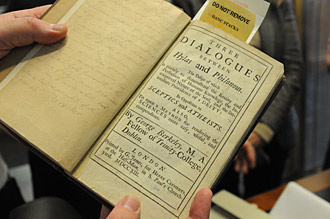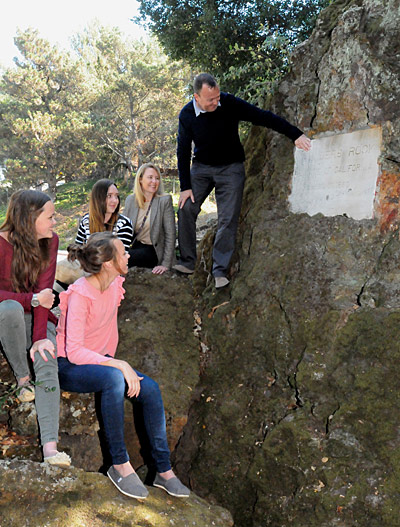The Berkeley family — those Berkeleys — come to town
An Australian family of five, descendants of the Irish philosopher who gave Berkeley its name, spent a half-day touring campus on Thursday. They're the only family members known to have paid a visit. And they stay true to the name's original pronunciation, "Bar-klee."
October 1, 2010
The esteemed Irish philosopher George Berkeley, bishop of Cloyne, never had a chance to see the campus and city that bear his name. He died more than a century too soon for that.
But on Thursday, the Berkeleys of Brisbane, Australia — father Sean, mother Marguerite, and daughters Harriet, Lily and Prue — made history by spending half a day exploring their ancestor’s artifacts here.
They are the only members of the bishop’s family ever to have paid a visit to the campus, at least in living memory. And they, like the bishop, pronounce their name “Bar-klee.”
Sean Berkeley, who owns a wholesale book business, is a direct descendant of Bishop Berkeley’s brother, Robert. How many generations removed?
“He was my great-great-great- … I’m not sure. Quite a few!” said Berkeley, in a joking comment that belies the serious study the family has made of their prominent ancestor. They have toured Whitehall, the house near Newport, R.I., where George Berkeley lived and wrote for three years in the early 1700s. They’ve been to Trinity College in Dublin, where he was a student and professor for many years. And they’ve examined first editions of his books in the British Library in London.
The Berkeleys arrived on campus at the end of a two-week trip that also took them to Newport, New York and Los Angeles. It was the girls’ first time in the United States, and the first trip to Berkeley for all of them.
Welcoming them at Moses Hall was Paolo Mancosu, chair of Berkeley’s philosophy department, who teaches George Berkeley’s work in his classes. Berkeley was one of the first important idealist philosophers, as well as a mathematician, Mancosu said.

At the Bancroft Library, one of the rare early editions of Bishop George Berkeley’s work.
He didn’t quite ask, as some have said, that “if a tree falls in the forest and no one hears it, does it make a sound?” But his writings established the same idea: that the mind creates reality, that to be is to be perceived, Mancosu explained.
At the Bancroft Library, leather-bound first and early editions of a half-dozen of Berkeley’s essential writings were rolled out for the family to view in a small glass-enclosed room. The oldest, the Arithmetica, from 1707, was in its original binding. “This is the find,” said Mancosu. “He wasn’t even a professor yet.”
At the Berkeley Art Museum, a bigger-than-life-size portrait of George Berkeley, in lace cuffs and collar, had been pulled from storage for the Berkeleys’ visit. Painted by John Weir, it was given to the campus in 1873 by Frederick Billings, the college trustee credited with coming up with the idea of naming the campus after Berkeley. The portrait hung in an administration building and then the chancellor’s home until the early 1990s.
The Berkeleys have seen a few portraits of the bishop, and have one hanging in their home, but this was the biggest, Sean Berkeley said.
They found the suggestion of a family resemblance. “I think it’s the chin,” said Prue. “It’s the bags under the eyes,” joked her father.
Unobtrusively painted into the background is the line written by George Berkeley that is credited with inspiring Berkeley as the name for the new college and its town:
“Westward the course of empire takes its way …”
After a golf-cart tour of the campus, the family heard the tale on a stop at Founders’ Rock, the outcropping at the northeastern corner of campus where a plaque notes the dedication of the campus in 1860.
George Berkeley had written his famous line — part of a poem called “Verse on the Prospect of Planning Arts and Learning in America” — in 1726, as he prepared to sail to England’s colonies with his family. His plan was to build a school in Bermuda to educate and evangelize native Americans.
Money promised for the venture never came through, but in Berkeley’s three years in Rhode Island, he made a name for himself in education. He had a hand in starting Yale, Columbia University and the University of Pennsylvania before returning to Ireland, where he was named Anglican bishop of Cloyne.

At Founders’ Rock, the spot that inspired Berkeley’s name, the family checks out the plaque marking the campus’s dedication in 1860. Left to right: Lily, Prue, Harriet (behind), Marguerite, Sean.
At Founders’ Rock, campus planning analyst and historian Steve Finacom told the story of how the site played an important role in how Berkeley got its name. The year was 1866, six years after the trustees of the young Oakland-based College of California had picked a new site and held their dedication.
The college still lacked a name — and the college trustees faced a deadline. Some of the trustees paid a visit to the rock, among them Billings, a lawyer who was one of the most prominent men in California after overseeing the completion of the Northern Pacific Railroad.
Billings looked out at the Golden Gate and recited the “westward” line. The others, educated men, recognized it as George Berkeley’s — and someone said the equivalent of, “Let’s name it Berkeley.” Finacom, based on research conducted by early local historian William Warren Ferrier, says the idea probably was talked about later in the day over lunch, and in the afternoon it was official, by vote of the trustees.
Berkeley, it was. (No one, however, has fully explained the change in pronunciation.)
The Brisbane Berkeleys are the fourth generation of the family to live in Australia. Sean’s grandfather was the one who traced their connection to their British forebears, in an exchange of letters in the 1950s, before Google and email made such things easier. When the last of their branch of the UK Berkeleys died, he inherited the portrait and a trunk full of Bishop Berkeley’s possessions.
Sean’s father, who was director general of the Australian state of Queensland, sparked his son’s interest in their family history.
Following Berkeley family tradition, as the first-born son, Sean should have been named George — but “his mother said it was too serious a name for a bonny boy,” Marguerite said.
During each of her three pregnancies, “we had the name ready,” she said. “But we were never able to use it.”
The family poodle is left to carry on the custom. Her name is Georgie.
For their last stop of the day, the family descended on the ASUC store, and the girls disappeared to try on souvenir sweatshirts emblazoned with the Berkeley name — one they won’t have any trouble remembering.